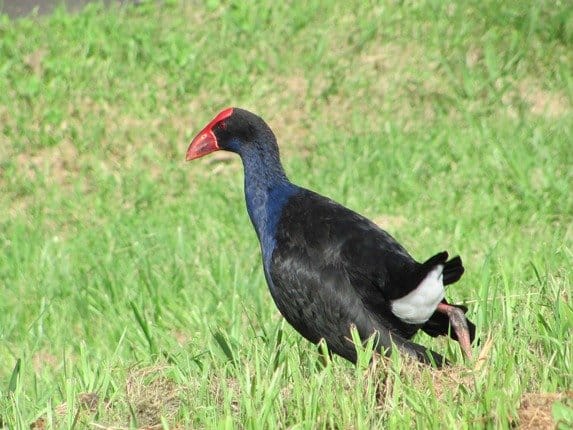
This post was originally posted 0n 22 April 2012 but has been reposted in honor of the Purple Swamphen (finally) being added to the American Birding Association checklist.
Purple Swamphens are large gallinules and despite their name they are not actually “purple”, but it’s amazing what you can get away with when naming birds! They are a magnificent blue with a red frontal shield and stout bill. We have discovered that they are more likely to show their “love” for each other in areas where they have some onlookers and can even be quite devious. As this is “Bird Love Week” I will share our knowledge.
Around Broome we have some fresh water clay pans and this is where you are most likely to hear them and then see them crash amongst the reeds. You occasionally see a nest platform, but to venture into an area where crocodiles may reside would be foolish and so we have not seen much in the way of “love”. Not many onlookers-nobody to impress.
Purple Swamphen habitat near Broome
When we visited Perth & visited Herdsman Lake we found them rather elusive, but did get good views of one near a boardwalk.
Purple Swamphen at Herdsman Lake, Perth, Western Australia
On our trip to Tasmania we discovered a Purple Swamphen with a chick, so we knew they’d been up to something. They didn’t want to be photographed and the attempt I made was poor, but you can see there is a small bird…evidence that something has happened.
Purple Swamphen and chick
As you are aware from my recent posts, we have had a trip to Sydney this year and there are plenty of onlookers there! We had a family group at Olympic Park and they were not at all bothered by our presence and I was able to take some nice photographs.
Adult Purple Swamphens
Juvenile Purple Swamphens
The busiest place that we visited on our trip to Sydney was Centennial Park and it was a Sunday, so there were plenty of people out enjoying the sunshine. This is where we discovered that Purple Swamphens are not at all shy when given the opportunity to show their “love” for each other. I mentioned them being devious….well here’s the evidence…leading a child to the action…
Our nephew, George, being shown what goes on in the park on a Sunday afternoon
If you are 6 and new to birding you just follow the bird…this is where the bird thinks to itself…time for some education on “love”. George wasn’t ready…Uncle Grant was and he took the photos.
Purple Swamphen “love”
George didn’t say anything more than “I should have got a photo of that”…yes you should…you don’t get many seconds when it comes to birds and “love”!! So, there is an onlooker…who is the other bird?
…
A fish may love a bird, but where would they live?
-Drew Barrymore
Bird Love Week is seven days of exploration of avian amore here on 10,000 Birds from April 22-28. We love birds, and the topic of birds loving other birds and in the process making more birds is a fascinating one we know you will enjoy. Mike, Corey, and a bevy of Beat Writers have been working on this one for awhile as the perfect expression of our love of all things avian. To see all of our Bird Love Week posts, just click here. But be warned – Bird Love Week is neither for the faint of heart nor for the permanently prudish – you may end up with images that you never imagined seared onto your brain.
………























Wait, so birds also watch other birds? I find that more creepy than birders!
Great show Clare M. I find it similar to our Gallinules, I wonder how many million years ago they split into the differet Rallidae families.
Interesting post and beautiful birds! With feet like those, their love is pretty remarkable! Coincidentally, I just photographed something that looked so bizarre as I was driving past- a couple of our neighbor’s ducks in their moment of avain love, surrounded by four gawking ducks. (It did look rather creepy.)
Maybe some birds learn by watching other birds! Or maybe they are just showing off! 🙂
This reminds me of seeing a both chicks and nest-building at
Hasties Swamp when I was in Queensland. That place was full of swamphens when I was there. Watching the swamphen cutting pieces of vegetation then taking them back to add to her nest was quite interesting.
For what it is worth, I think the Purple Swamphens I’ve seen in Florida were closer to being purple than the ones I saw in Australia. They seem to vary a lot depending on which population they’re from.